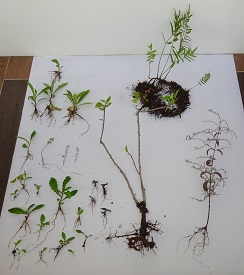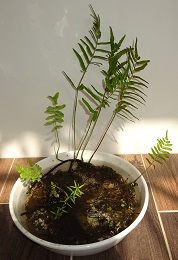| Home | Nature Weekly Index |
8 February 2015 | Swamp Fern | Cyclosorus interruptus |

 As part of my clean-up exercise on the old potted plants that lined my balcony, I dissected another of the pots last weekend. This
particular pot was around for at least 3 years now. The main reason for it to stay that long was the
Hibiscus plant that reside in it. Although it had passed its prime time, I was
still hoping for miracle of its re-growth or maybe for sentimental reason.
As part of my clean-up exercise on the old potted plants that lined my balcony, I dissected another of the pots last weekend. This
particular pot was around for at least 3 years now. The main reason for it to stay that long was the
Hibiscus plant that reside in it. Although it had passed its prime time, I was
still hoping for miracle of its re-growth or maybe for sentimental reason.
Besides the most common resident plant species, Hippobroma longiflora, there was one Andrographis paniculata, several small Hemigraphis reptans, two young Senega paniculata, one seedling of Macroptilium lathyroides and a mid-size fern, Cyclosorus interruptus. Except for the Hibiscus, all the others came about spontaneously. The fern was the focus of this excavation. The common name of Cyclosorus interruptus is Swamp Fern. When compared the wild ones, this pot fern was relatively small, most likely due to the restriction of space.


 It took me substantial effort to extract the fern out of the soil. Though its rhizome might be just creeping on the surface of the
soil, it had a very extensive root system that penetrated deep beneath the soil and gripped tightly to soil particles. After the
extraction, I soaked it in water to get rid of the soil but was not too successful. After the picture-taking session, I kept it in
a water habitat by having its rhizome submerged in water to determine whether it will survive in such aquatic environment.
It took me substantial effort to extract the fern out of the soil. Though its rhizome might be just creeping on the surface of the
soil, it had a very extensive root system that penetrated deep beneath the soil and gripped tightly to soil particles. After the
extraction, I soaked it in water to get rid of the soil but was not too successful. After the picture-taking session, I kept it in
a water habitat by having its rhizome submerged in water to determine whether it will survive in such aquatic environment.
After a week, it seemed to be doing well in the water habitat. I was conscious that the pool of water might attract mosquitoes and had been checking it daily on the presence of any lava. If found, the lava will be serve as extra delicacies to the guppies in the neighbouring tank.
Even after removing this pot, I still had 2 Swamp Fern colonies in 2 other pots.
Update: 30 July 2017
This fern was still around my potted area after more than 2 years and I had written another post on it in July 2017.